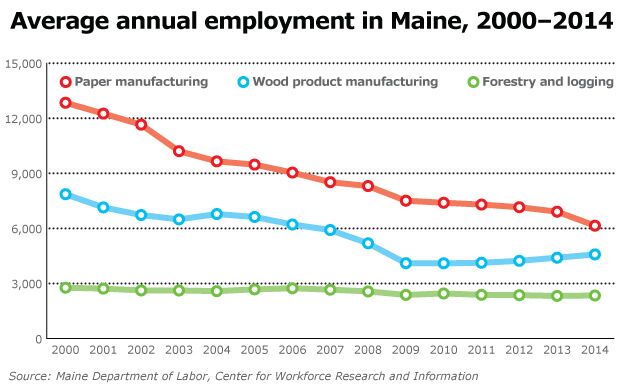Stakeholders vow to work together to lower costs for Maine's pulp and paper industry
It's been hard to find many bright spots for Maine's pulp and paper industry this year, given the steady drumbeat of headlines about mills shutting down or downsizing, worker layoffs, bankruptcy foreclosures and auctions and property tax abatement requests.
But, as the industry looks to the future, at least three bright spots were indeed highlighted during the Maine Pulp & Paper Association's all-day summit on Nov. 17 in which paper mill managers, loggers, paper workers, sawmill operators, policy-makers and a host of other stakeholders came to Bangor with a sense of urgency about the pulp and paper industry's future in Maine. Here's some of the good news shared by several speakers:
- St. Croix Tissue is investing $120 million to build a new state-of-the-art tissue paper manufacturing facility in Baileyville. Two automated tissue paper machines are being installed and upwards of 80 new jobs will be created when the plant opens next year adjacent to parent company Woodland Pulp LLC's mill, which is Washington County's largest employer with approximately 320 jobs.
- New Brunswick and Maine Railways, a short line railroad subsidiary of J.D. Irving Ltd. that took over an endangered network of branch lines northern Maine, has increased the number of wood fiber trainloads transported on its lines from zero in 2006 to 10,000 loads in 2015. Since a freight train can move a ton of freight using far less fuel than truck transportation, that's helping to reduce shipping costs.
- Paper in 2014 was Maine's top export, valued at $484 million, surpassing fish and other marine products ($434 million); oil and gas ($278 million); computer and electronic products ($260 million); and transportation equipment ($209 million).
Innovation and investment may be keys to success, as the summit's organizers repeatedly emphasized, but they were careful not to sugarcoat that message by ignoring the economic realities behind the recent news stories — which, in the very week of the summit, include Verso Corp. considering the sale of its Androscoggin Mill in Jay, which already faces layoffs of 300 of its 865 workers by year's end due; and a bankruptcy judge's approval on Nov. 20 of a $5.95 million bid for the bankrupt Lincoln Paper and Tissue mill by a group led by a Boston-based liquidator of industrial sites.
“Challenging times call for different approaches. That's why we're all here today,” says Donna Cassese, wood resource manager for Sappi Fine Paper in Maine and chairwoman of the Maine Pulp and Paper Association. “These are challenging times and we mean to change.”
Benchmarking Maine
Eric Kingsley, vice president of Innovative Natural Resource Solutions, a consulting firm with an office in Portland, set the stage for understanding the economic challenges all Maine paper mills, even the successful ones, now face in a global marketplace. Hired by the state to compare Maine's pulp and paper industry costs against other leading states, the firm's benchmarking report makes a factual argument that across the board Maine costs are higher than competing pulp and paper states in the Midwest, Southeast and Northwest.
Based on 2013 data, Maine's industrial electricity cost of $83.40 per megawatt hour is almost double its lowest competitor (Washington, $42.30/MWh) among the other leading pulp and paper states of North Carolina, George, Louisiana, Mississippi, Michigan, Wisconsin, Minnesota and Washington. [See charts on Page 19]. Its natural gas cost of $10.32 per million cubic feet is almost triple the lowest competitor (Louisiana, $3.86).
Comparing Maine's wood fiber costs is more complicated, Kingsley says, since it involves a number of variables, including hardwood versus softwood percentages, distances traveled and acreage under private ownership. Perspectives vary too. Typically, he says, the mill owners' perspective is “Why are the costs of wood in Maine so high?” The landowners' perspective is, “Why do I get paid so little?” And the logger wonders, “Why am I $1 million in debt?”
In a separate analysis published earlier this fall, Kingsley makes the point that the 2013 closure of the Great Northern Paper mill in East Millinocket and the 2014 closure of Verso's mill in Bucksport resulted in the loss of more than 1 million tons of pulpwood demand annually. But there hasn't been a corresponding drop in price, he notes, as might be expected in applying the basic economic law of supply and demand.
Kingsley explains why pulpwood prices have remained strong, citing “a confluence of events” at work in the region. These include “market diversification” giving landowners, loggers and foresters more markets for low-grade wood and “product diversification.”
“Pulp isn't the only game in town,” he writes. “During the same period that the region lost two paper mills, it gained a new biomass plant in New Hampshire with an average annual consumption of 750,000 tons of fuel. Over the last few years, wood pellet mills have been successful, and the region has even experienced a few periods of 'shortages' of wood pellets and dried firewood. Every ton of pellets or cord of firewood delivered to heat someone's home is a ton of wood that a pulp mill won't utilize.”
Demand isn't falling so much as it's shifting to other markets, which is helping to keep prices up.
Another factor, he adds, is the loss of logging capacity, as smaller loggers “often disappear when a mill does.” High entry costs also make it harder for new loggers to come into the market.
“When enough of these small loggers disappear … it can be a big deal. Likewise, the trucking sector is also beginning to experience the same challenges.” At the Bangor summit, Kingsley concluded, “The trends suggest it will get worse before it gets better.
The bottom line: Maine's higher wood fiber costs contribute to the state being a net importer of more than 2,500 tons of wood from New England, Maritime Canada, New York, Quebec, and even Michigan.
The logger's perspective
Dana Doran, executive director of the Professional Logging Contractors of Maine, confirmed Kingsley's sense of a looming shortage of loggers. Next to paper mill workers themselves, Doran says, loggers and their families are among the hardest hit when mills shut down or downsize.
“It's not a good situation out there right now,” Doran says. “In the last four months I've heard from six of our members that they're going out of business. My prediction right now is that by the mud season of 2016 we're going to see a reduction probably of 10% to 15% in total logging capacity in the state of Maine. That is a tough story to tell, but it's the reality of the situation.”
But Doran flatly rejects what he characterizes as a “common misconception” that the high cost of wood fiber in Maine is due to loggers' inefficiency and high profit margins.
“On our costs, we have seen minimal rate increases, but we've had to invest in productivity because the mills have wanted that productivity,” Doran says. “People want to stay in business — we're competitive people so we've made those investments.”
But there are investment costs related to that increased productivity, he says.
Doran illustrated that point by comparing the cost of investing in a cable-skidder and operator combination for between $175,000 and $200,000 in the year 2000 to the cost of investing in a modern feller buncher and an operator trained to run it in 2015. “Now you’re talking about an investment of $550,000,” he says. "Yes, productivitiy increases," but the combination of higher overhead and lower demand is cutting into profitability and is creating extremely tight margins for many Maine loggers."
Sticking to the summit's theme of innovation and investment, Doran highlights initiatives Maine's logging industry is pursuing in response to the overarching goal of improving the competitiveness of the state's wood products industry. Among them:
- A new mechanized logging operations training program is being developed with three Maine community colleges, with support from Milton CAT and CAT Forest Products, to meet the demand for skilled workers as mechanization increases and older workers retire.
- An aggressive safety training program launched to reduce risks, work injuries and thereby reduce operating costs.
- Working with lawmakers to pass a sales tax exemption on fuel for loggers similar to the one currently available to professional fishermen.
- Exploring cooperative buying opportunities to reduce overall operating costs, including the possibility of creating a “first-ever cooperative buying program” for fuel for PLC members.
- Countering negative perceptions of logging and loggers by emphasizing the high professional standards and sophisticated skills needed in today's industry.
“We want to work with the mills to lower costs,” Doran says, “by reducing transportation costs and incentivizing new markets for local fiber resources. This glass is half full; it's not half empty.”
Challenges and opportunities
Other speakers at the summit reiterated Doran's “glass half full” theme, identifying problems but also highlighting or suggesting possible solutions.
Patrick Woodcock, director of the Governor's Energy Office, says the low price of oil is helping to reduce the cost of electricity in the short-term, with the Maine Public Utilities Commission approving lower standard offer prices for both Central Maine Power Co. and Emera Maine residential and medium business customers for 2016.
Ultimately, Woodcock says, the key to achieving long-term reductions in the cost of both electricity and heating is increasing natural gas capacity by enabling more gas to flow from the Marcellus Shale deposits in Pennsylvania and New York into New England and ultimately Maine. “There is no daylight between the New England governors” and Maine Gov. Paul LePage on the need to act quickly on that front, he says. “They have seen what high energy costs do to their economies.
Property taxes are another high benchmark cost for Maine paper mills, says Jon Block, a tax attorney at Pierce Atwood and moderator of the summit's tax policy discussion. One paper company, he says, collectively pays $10.6 million in annual property taxes for six operating mills outside Maine and $7.4 million for its one mill in Maine. That kind of disparity, he says, inevitably puts a red flag on the P&L statements of Maine mills owned by companies with mills paying lower taxes elsewhere.
Although Maine has two programs to encourage business investment in new equipment — the Business Equipment Tax Reimbursement and Business Equipment Tax Exemption — Block pointed out that pre-1996 equipment is still taxed, adding to the property tax burden at older mills.
Potential action steps identified by audience members during the summit's “next steps” discussion include:
- Working with lawmakers and the governor's office to expand the BETR and BETE programs to include older equipment.
- Shifting to an “income-based” approach for determining property taxes of large industrial companies like paper mills.
- Establishing a streamlined property tax appeal system in which abatement requests and appeals would be heard by a professional board instead of local citizens who might not have the tax expertise to fairly evaluate the merits of a paper mill or other large industrial taxpayer's abatement request.
Although stakeholders' views were mixed on what comes next, it was abundantly clear by the summit's closing that doing nothing is not an option. Employment at Maine's paper mills fell from 12,087 in 2000 to 6,150 in 2014, according to Amanda Rector, the state's economist.
Cassese and fellow summit facilitator Andrea Cianchette Maker, co-leader of Pierce Atwood's government relations practice group, noted that the board of the Maine Pulp & Paper Association would use findings from the summit to create and propose short- and long-term solutions. Cassese says: “I'd like to get a couple of quick wins in the short session of the 127th Legislature, and build some momentum with that. That's because we know some of the things we talked about today will be a long, involved process.”
George Gervais, commissioner of the Maine Department of Economic and Community Development, says the report by Eric Kingsley, “Benchmarking Maine's Forest Industry,” provides a “road map.”
“Maine needs to lower taxes, energy costs, and wood costs,” Gervais says. “As an administration, we will continue pushing these initiatives which are absolutely critical to increasing Maine's overall competitiveness and ultimately help strengthen the pulp and paper industry for generations to come.”
Editor's note: This story has been updated to clarify comments made at the summit by Dana Doran, executive director of the Professional Logging Contractors of Maine, about higher overhead costs facing today's loggers. The earlier version had omitted the comparison figures and time-frame for the comparison.
Read more
Madison Mill production schedule in further flux
Madison Paper mill shuttering in May
Jay mill owners dispute tax valuation from town
Employees return to work at Rumford paper mill following machine restart
It's official: Obama designates north woods national monument
Maine reacts to the opening of $120M St. Croix Tissue mill
Ashland pellet mill to boost employment after landing UMFK contract














Comments